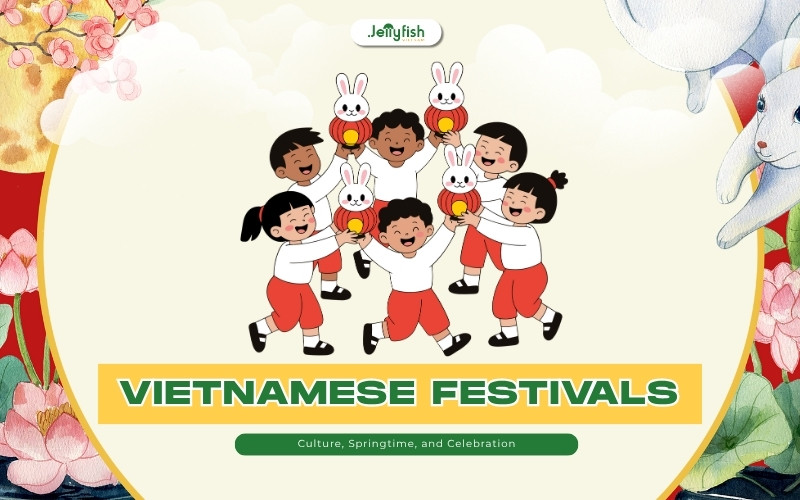Vietnam is a land of vibrant traditions, and its festivals reflect a rich blend of history, religion, and community. From the northern highlands to the Mekong Delta, Vietnamese festivals offer moments of joy, connection, and cultural pride. This article by Jellyfish introduces you to the country’s most significant festivals and celebrations, highlights why spring is often the peak season, and uncovers the cultural values that shape each occasion.
1. The Cultural Heartbeat of Vietnamese Festivals
Festivals in Vietnam are more than public holidays — they are deeply tied to:
- Ancestral worship
- Agricultural cycles
- Religious beliefs
- Community bonding
Whether rooted in Buddhism, Confucianism, animism, or folklore, Vietnamese festivals and celebrations bring people together with food, music, games, rituals, and vibrant costumes.
2. Top Vietnamese Festivals
Here are some of the most popular and culturally significant Vietnamese festivals:
2.1. Lunar New Year
Date: beginning on the first day of the lunar new year
Where: Nationwide
Tet stands as Vietnam’s most significant annual celebration. Families clean their homes, cook traditional dishes, visit relatives, and honor their ancestors.
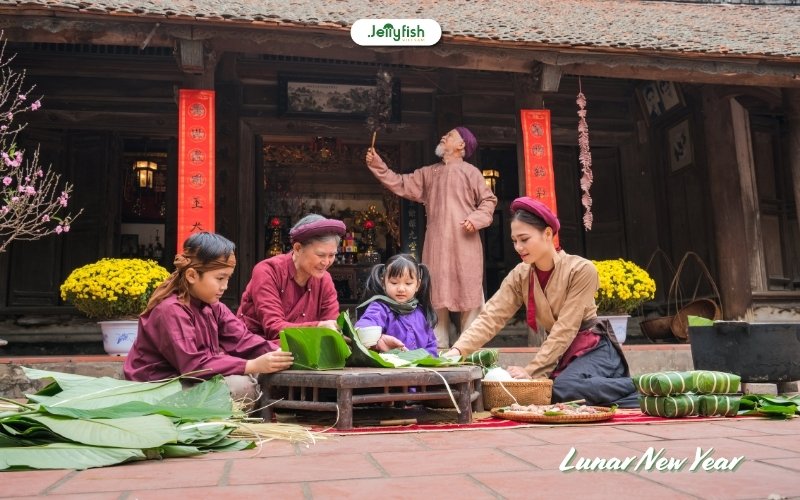
Highlights:
- Bánh chưng and bánh tét
- The tradition of giving out lucky money
- Fireworks and lion dances
- Paying a visit to pagodas on New Year’s Day
Tết marks a fresh beginning and reflects the core of Vietnamese festivals and celebrations.
VIEW MORE: ALL ABOUT LUNAR NEW YEAR IN VIETNAM
2.2. Hung Kings’ Temple Festival
Date: 10 March (lunar calendar)
Where: Phú Thọ Province
This festival honors the legendary founders of Vietnam — the Hùng Kings.
Activities include:
- Incense offering ceremonies
- Folk music
- Traditional games
- Festive processions in cultural costumes
It reinforces national pride and remembrance of origins.
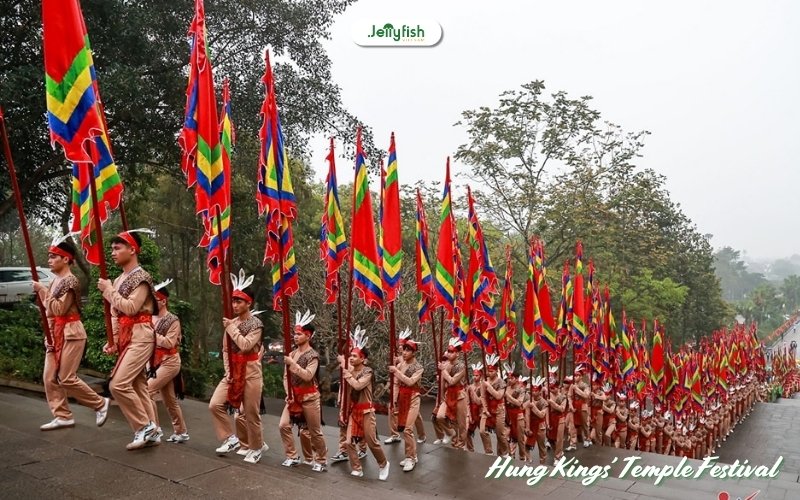
2.3. Perfume Pagoda Festival
Date: Mid-January to late March (lunar calendar)
Where: Hanoi (Hương Sơn, Mỹ Đức district)
This is one of the Vietnamese festivals often taking place in spring, blending pilgrimage with nature tourism.
Highlights:
- Boating on scenic rivers
- Visiting pagodas and caves
- Mountain treks and spiritual rituals
It attracts thousands of Buddhists seeking blessings and peace for the year ahead.
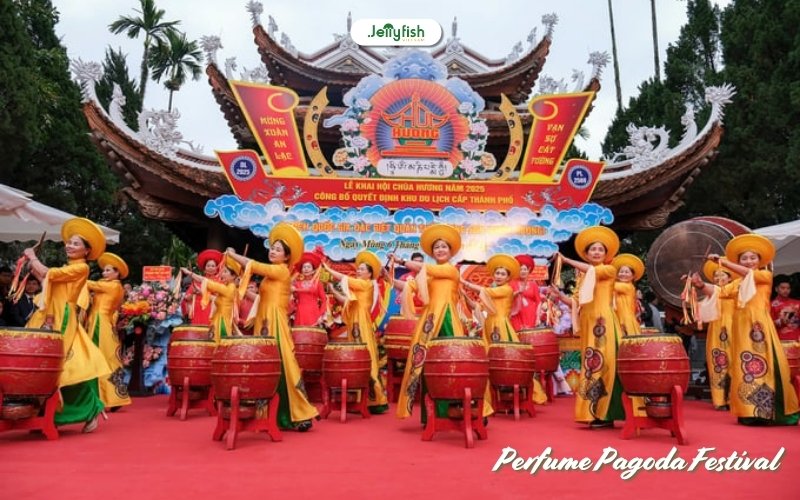
2.4. Lim Festival (Lễ hội Lim)
Date: 13 January (lunar calendar)
Where: Bắc Ninh Province
Famous for preserving Quan họ singing, a UNESCO-recognized folk music tradition.
What to expect:
- Antiphonal love songs
- Cultural activities including bamboo swing competitions and traditional wrestling
- People in four-panel traditional dress and headscarf (traditional costumes)
This festival celebrates both courtship and cultural heritage.
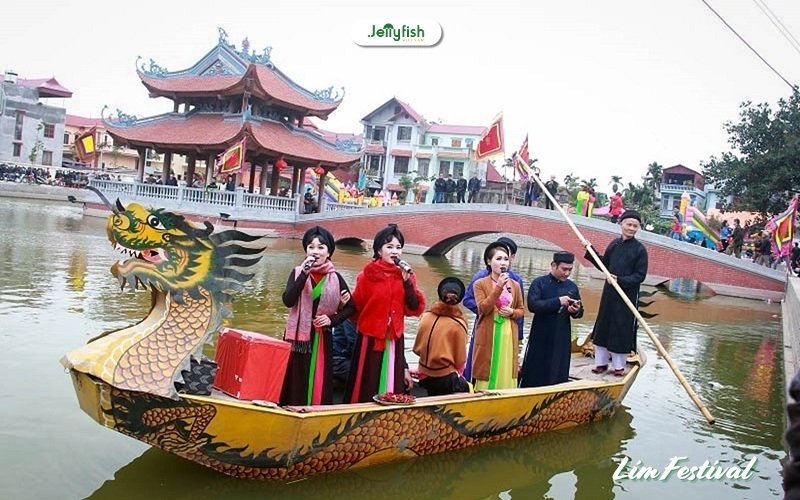
2.5. Mid-Autumn Festival
Date: 15 August (lunar calendar)
Where: Nationwide
Originally for harvesting, this has become Vietnam’s Children’s Festival.
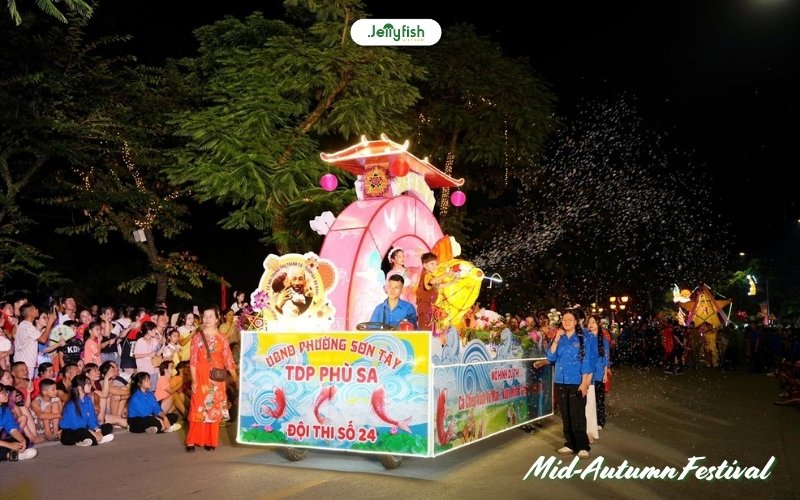
Festivities include:
- Lantern parades
- Lion dances
- Mooncakes and fruit trays
- Folk tales like Cuội and Hằng Nga
A joyful time for family bonding and storytelling.
VIEW MORE: TRADITIONAL ACTIVITIES IN VIETNAM’S MID-AUTUMN FESTIVAL
3. Vietnamese Celebrations
In addition to traditional cultural festivals, Vietnam also observes several modern celebrations and national holidays that commemorate significant historical milestones. These occasions unite the entire nation and often come with official days off for workers, students, and families, creating time for rest, travel, and meaningful reflection.
3.1. Reunification Day – April 30
- Historical Significance:
Reunification Day, celebrated on April 30, marks the complete victory of the Vietnamese people in the struggle against U.S. forces that brought about the liberation of the South and the nation’s reunification. It stands as a powerful symbol of peace, independence, and national unity.
- Key Activities:
- Large-scale parades and official ceremonies in major cities such as Hanoi and Ho Chi Minh City.
- Cultural and musical performances, as well as spectacular fireworks displays.
- Streets decorated with national flags, banners, and colorful lights.
- Public Holiday Duration:
- According to government regulations, workers, students, and public employees typically receive 2–4 days off, often combined with International Labor Day (May 1) for an extended holiday.
- Many families use this time for homecoming trips, vacations, or joining local celebrations.
3.2. National Day – September 2
- Historical Significance:
National Day, observed on September 2, commemorates the historic moment in 1945 when President Ho Chi Minh proclaimed Vietnam’s independence at Ba Dinh Square in Hanoi. This important national holiday is also affectionately known by many Vietnamese as the Independence Festival, reflecting its significance as a day of freedom and national pride. - Key Activities:
- Flag-raising ceremonies, parades, and patriotic gatherings across the country.
- Fireworks shows, cultural festivals, and public performances in major cities.
- Historic sites and museums often open with free or discounted admission.
- Public Holiday Duration:
- People across Vietnam, including workers, students, and government employees, typically enjoy 1–2 days off. Some years offer longer breaks when the holiday is adjacent to a weekend.
- Families and travelers take advantage of the time off to visit relatives, go on trips, or participate in public celebrations.
3.3. Other Modern Celebrations
Beyond the two major national holidays, Vietnam also observes several modern celebrations that honor different aspects of society:
- International Women’s Day (March 8) and Vietnamese Women’s Day (October 20): recognizing women’s contributions.
- Vietnamese Teachers’ Day (November 20): celebrating educators’ dedication.
- War Invalids and Martyrs’ Day (July 27): paying tribute to national heroes.
- Various provincial or regional anniversaries linked to local historical events.
While these occasions may not all include nationwide days off, they carry significant cultural and social importance.
4. Why Vietnamese Festivals Often Take Place in Spring
Many Vietnamese festivals often take place in spring for cultural and symbolic reasons:
- Lunar New Year (Tết), the biggest festival, falls in late January or February
- Spring symbolizes renewal, luck, and fertility
- Farmers celebrate the end of winter and prepare for planting season
- It’s also when weather is mild and ideal for outdoor events
This makes springtime the most festive and spiritually rich season across Vietnam.
Vietnamese festivals are a beautiful expression of the country’s traditions, beliefs, and joy. Whether you’re celebrating Tết with a family in Hanoi, lighting lanterns in Hội An, or joining a spring pilgrimage in the mountains, you’ll find that every festival is a bridge to the heart of Vietnamese identity.
Explore Vietnamese Culture and Language with Jellyfish
Want to understand more than just the celebration? At Jellyfish, we offer Vietnamese language and culture courses that help you:
- Learn holiday-related vocabulary
- Understand festival traditions from north to south
- Join conversations and events with confidence
Please leave your information via the registration form, we will contact you!
👉👉 Learning Vietnamese – Jellyfish Vietnam
✦ Hotline: 096 110 6466
✦ Head office: 1st Floor, Web3 Tower Building, Alley 4 Duy Tan Street, Cau Giay District, Hanoi
✦ Branch office: 2rd Floor, SH5.11 Vinhomes Marina, Vinh Niem, Le Chan, Haiphong
✦ Head office in Japan: 4F Westhill Building, Nishigotanda 2-24-4, Shinagawa, Tokyo, Japan


